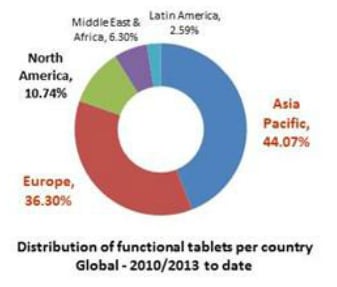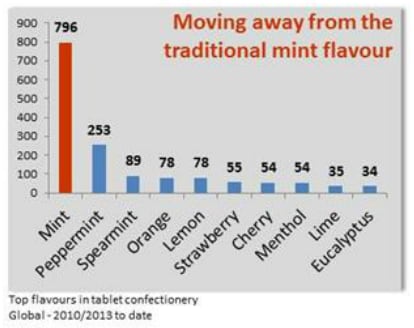Speaking at a webinar in collaboration with Roquette, Yannick Troalen, trends & innovation consultant at Mintel said: “The first function of tablets is to deliver freshness – that’s what consumers expect.
“But there is room to grow for oral care claims and in particular the main thing is tooth mineralization -this is a rising trend in Europe at the moment.”
Oral care: tooth mineralization and tongue scratching
23.8% of all tablets launched in the market between 2010 and 2013 have had a claim for breath freshening, according to Mintel data.
“However, we do see a rise in oral care claims. It’s mainly seen in Europe,” said Troalen. 5% of all tablets launched between 2010 and 2013 have made this claim.
The analyst said oral care claims came mainly through using polyol instead of sugar, enabling a claim for maintaining tooth mineralization, which essentially prevents tooth decay.
UK firm Peppersmith for example uses xylitol in its mints and has been accredited by the British Dental Health Foundation to say the product helps reduce the risk of plaque and tooth decay
Troalen added that “tongue scratching”, which removes bacteria on the tongue through rough textured products to freshen breath, was now fairly common in Asia among companies such as Japanese firm Ezaki Glico.
Other functional benefits: vitamins, minerals & energy

“There are more and more companies that are enriching their products with several vitamins and minerals. This is a trend that we mainly see in Asia, but is also being seen in Europe,” continued the analyst.
“The number one vitamin is Vitamin C.”
Energy products also appear to be making a move into the tablet category through brands such as Pow Peppermint in India, which contains taurine, caffeine and B vitamins.
Meanwhile, some products in China are using beta-carotene to make claims on eye health, but Mintel doesn’t see this becoming mainstream due to tougher regulations in Europe.
Flavor and texture
Mint and its derivatives, peppermint, spearmint and menthol are the main flavor choices in the tablet category accounting for around 90% of all launches globally.
According to Troalen, there are some citrus flavors such as orange, lemon and lime being used, but mint was so dominant in the category because people expected a breath freshening effect.

“A few companies, especially in Asia, are launching products with dairy flavors, which seems to be a popular flavor profile at the moment.” This includes things like milk and yoghurt, which can also be associated with health benefits.
In the US, brands such as Tic Tac and Altoids are also using spices such as ginger or cinnamon.
“Texture is also a very important platform for product development, especially in the tablet category,” added Troalen. “We see much more confectionery being launched with either double or triple layers and also more confectionery using the inclusions of mint crisps within the tablet.”
Hershey for example does a dual layer tablet product for its Ice Breakers brand that has one side of the traditional tablet with mint crisps and a another layer with fruity flavors, which also has a rough texture to help clear bacteria on the tongue.
